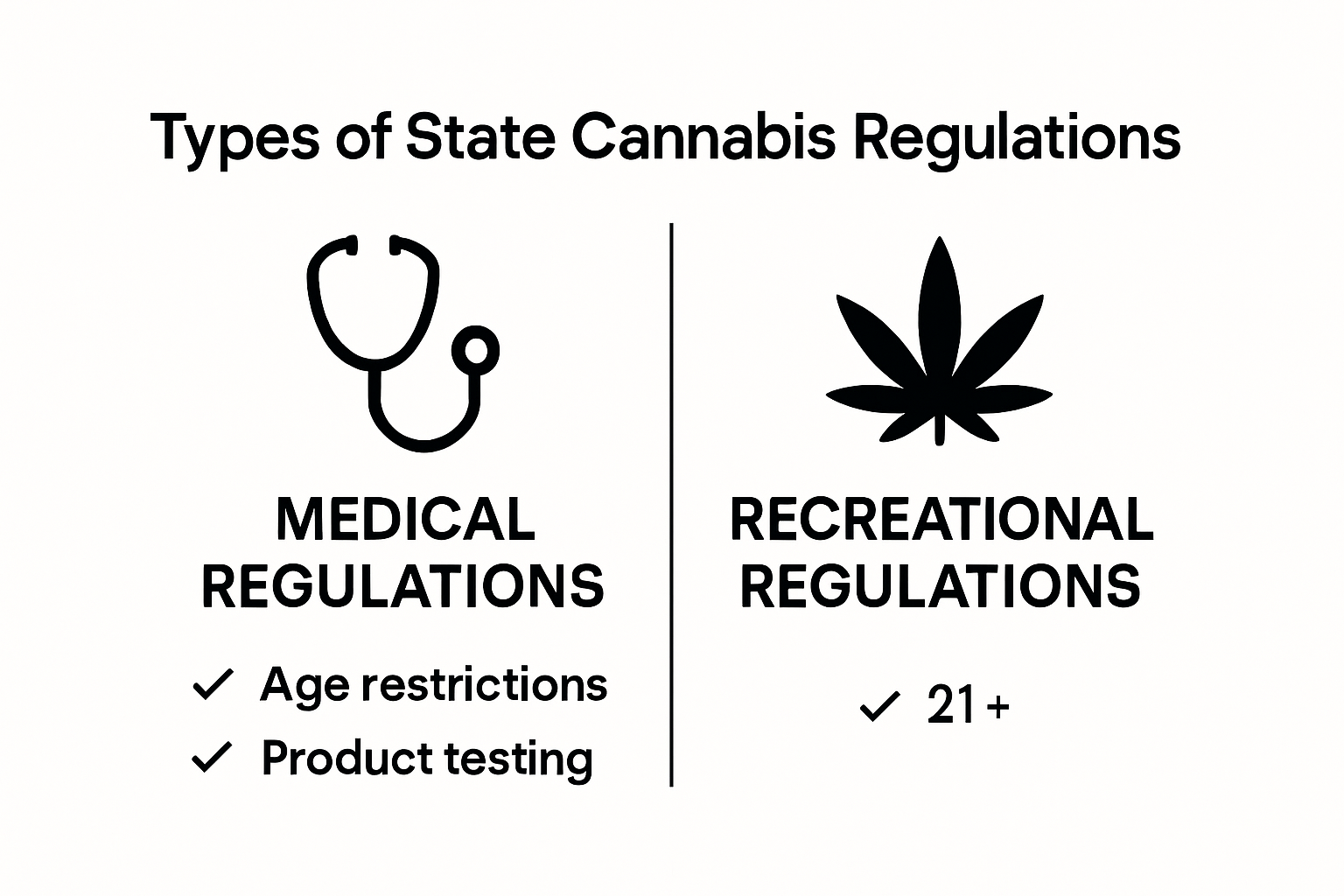Blog
Understanding the Role of State Regulations in Cannabis
State regulations shape every move in the cannabis industry and their influence stretches from who can grow marijuana to how safely it lands on store shelves. Most people focus on legalization headlines or product news. But the real story is in the details. As of 2024, 47 states run medical cannabis programs, each with its own rules and surprises. The catch is that these local laws can be so different that they actually shape the quality, safety, and daily experience of cannabis for everyone involved. Curious where the real decisions are made? It starts with understanding how states each draw their own lines.
Table of Contents
- What Are State Regulations And Why They Matter
- The Impact Of State Regulations On Cannabis Quality And Safety
- How State Regulations Shape Cannabis Retail And Access
- Navigating State Regulations: Challenges And Opportunities
- The Future Of State Regulations In The Evolving Cannabis Industry
Quick Summary
| Takeaway | Explanation |
|---|---|
| State regulations safeguard public health. | These laws establish guidelines for the safe production and distribution of cannabis products, protecting consumers. |
| Regulatory compliance offers business advantages. | Understanding and adhering to state regulations can help cannabis businesses build trust and differentiate themselves in the market. |
| Quality control is mandated by regulations. | States require strict testing and standards to ensure cannabis products are safe and properly labeled for consumers. |
| Licensing systems regulate retail operations. | States determine the number and location of cannabis retail outlets through complex licensing requirements, impacting consumer access. |
| Emerging trends focus on social equity initiatives. | New regulations increasingly emphasize social justice and economic inclusion in cannabis governance, shaping future market dynamics. |
What Are State Regulations and Why They Matter
State regulations in the cannabis industry represent a complex legal framework that governs the production, distribution, sale, and consumption of cannabis products across different jurisdictions. These regulations are crucial because they establish clear guidelines that protect public health, ensure consumer safety, and create standardized operational protocols for businesses.
Understanding the Legal Landscape
Cannabis regulations vary significantly between states, creating a diverse and intricate legal environment. According to CDC Cannabis Research, as of 2024, 47 states have established medical cannabis programs, each with unique regulatory approaches.
The table below summarizes the key components commonly addressed by state cannabis regulations and provides a concise explanation of each.
| Component | Explanation |
|---|---|
| Licensing Requirements | Rules for obtaining and maintaining a license to produce, distribute, or sell cannabis. |
| Product Testing & Quality Control | Mandatory procedures to ensure product safety, potency accuracy, and contaminant absence. |
| Age Restrictions | Legal minimum age limits for purchasing and consuming cannabis products. |
| Taxation Frameworks | Guidelines for applying and collecting taxes on cannabis sales and business operations. |
| Medical vs. Recreational Guidelines | Differentiated rules and access for medical patients compared to recreational consumers. |
- Licensing requirements for cannabis businesses
- Product testing and quality control standards
- Age restrictions and consumer accessibility
- Taxation and economic frameworks
- Medical versus recreational usage guidelines
Key Components of State Cannabis Regulations
State regulations function as comprehensive governance mechanisms that control every aspect of the cannabis ecosystem. They determine who can produce cannabis, how it can be processed, and under what conditions it can be sold. This includes detailed specifications about:

- Cultivation methods and permitted growing environments
- Packaging and labeling requirements
- Potency limits and chemical composition standards
- Transportation and distribution protocols
- Compliance and reporting mechanisms for businesses
The primary goal of these regulations is to create a safe, transparent, and accountable cannabis market that protects both consumers and businesses. By establishing clear rules and enforcement mechanisms, states can mitigate potential risks associated with cannabis production and consumption while supporting a legitimate and responsible industry.
The Impact of State Regulations on Cannabis Quality and Safety
State regulations play a critical role in establishing comprehensive quality and safety standards for cannabis products. By implementing rigorous testing, monitoring, and control mechanisms, these regulations directly influence consumer protection and product integrity across the cannabis industry.
Ensuring Product Safety Through Regulatory Standards
According to CDC Cannabis Research, state regulations create essential safeguards that protect consumers from potential health risks. These standards typically mandate:
- Comprehensive chemical and microbial contaminant testing
- Precise potency and cannabinoid concentration verification
- Rigorous screening for pesticides and harmful agricultural chemicals
- Tracking product origins and cultivation environments
- Mandatory reporting of production and distribution processes
Quality Control and Consumer Protection Mechanisms
State regulations transform cannabis product safety by establishing mandatory quality control protocols. These frameworks require producers to adhere to strict guidelines that minimize potential health risks. For those wanting to read more about safety compliance, understanding these regulatory nuances is crucial.
The primary objectives of these regulations include preventing contamination, ensuring accurate product labeling, and maintaining consistent product standards. By implementing comprehensive testing requirements, states can effectively monitor the chemical composition, potency, and potential contaminants in cannabis products.
These regulatory approaches not only protect consumers but also create a transparent and accountable cannabis market. They establish clear expectations for producers, distributors, and retailers, ultimately fostering consumer trust and supporting the responsible growth of the cannabis industry.
How State Regulations Shape Cannabis Retail and Access
State regulations fundamentally transform the cannabis marketplace by establishing intricate frameworks that control retail operations, consumer accessibility, and product distribution. These regulatory mechanisms directly influence how cannabis businesses operate and how consumers can purchase and consume cannabis products.
Licensing and Retail Frameworks
According to National Institutes of Health Research, state regulations create complex licensing systems that determine the number, location, and operational parameters of cannabis retail outlets. These frameworks typically include:
- Strict geographical restrictions on retail store locations
- Limited number of retail licenses per jurisdiction
- Comprehensive background check requirements for business owners
- Mandatory security and compliance protocols
- Specific zoning regulations for cannabis establishments
Consumer Access and Market Dynamics
State regulations significantly impact consumer access by defining who can purchase cannabis, where purchases can occur, and under what conditions. Learn more about product education to understand the nuanced landscape of cannabis retail regulations.
These regulatory approaches create a structured environment that balances consumer convenience with public safety concerns. By implementing controlled access mechanisms, states can manage potential risks associated with cannabis sales while creating a transparent and accountable retail ecosystem.
The intricate regulatory landscape means that cannabis retail experiences can vary dramatically between states. Some jurisdictions maintain tight restrictions that limit the number of dispensaries, while others create more open market frameworks. These variations ensure that each state can tailor its approach to local community needs and public health considerations.
Navigating State Regulations: Challenges and Opportunities
State cannabis regulations present a complex landscape of legal challenges and strategic opportunities for businesses and consumers. These regulatory frameworks require careful navigation, balancing compliance with innovation and market potential.
Regulatory Compliance Challenges
According to California State University Research, businesses in the cannabis industry face significant regulatory hurdles. These challenges include:
- Potential federal legal complications
- Strict documentation and reporting requirements
- Complex licensing and renewal processes
- Financial transaction restrictions
- Ongoing compliance monitoring and auditing
Strategic Opportunities in Regulatory Frameworks
While regulations create challenges, they also generate unique market opportunities for adaptable businesses. Explore our guide on understanding safety standards to gain deeper insights into navigating these complex regulatory environments.
Successful cannabis businesses recognize that robust regulatory compliance can become a competitive advantage. By developing comprehensive understanding of state-specific regulations, organizations can differentiate themselves through exceptional transparency, quality assurance, and consumer trust.
The evolving regulatory landscape demands continuous learning and strategic adaptation. Businesses must remain agile, anticipating potential regulatory shifts while maintaining unwavering commitment to legal compliance and consumer safety.
This table highlights the major challenges and strategic opportunities that cannabis businesses encounter when navigating state regulations.
| Regulatory Aspect | Description |
|---|---|
| Compliance Challenges | Complex legal requirements, strict reporting, licensing renewals, and federal risks. |
| Financial Restrictions | Barriers to banking and financial transactions due to cannabis federal status. |
| Strategic Opportunities | Ability to differentiate via compliance, transparency, and quality assurance. |
| Adaptation Benefits | Staying agile can help businesses lead as regulations evolve and new trends emerge. |

The Future of State Regulations in the Evolving Cannabis Industry
The cannabis industry stands at a pivotal moment, with state regulations rapidly transforming to address emerging market complexities, technological advancements, and evolving societal perspectives. These regulatory frameworks are becoming increasingly sophisticated, reflecting a nuanced approach to cannabis governance.
Emerging Regulatory Trends
According to Maryland State Cannabis Research, progressive state regulations are increasingly focusing on comprehensive social equity initiatives. These emerging trends include:
- Advanced social justice and economic inclusion programs
- More sophisticated product tracking mechanisms
- Enhanced consumer protection standards
- Integrated public health monitoring systems
- Dynamic licensing frameworks that support diverse market participants
Technology and Regulatory Innovation
State regulations are progressively incorporating technological solutions for compliance and monitoring. Learn more about customer insights to understand how technological innovations are reshaping regulatory landscapes.
The future of cannabis regulations will likely emphasize data-driven approaches, leveraging advanced tracking technologies, blockchain verification systems, and real-time compliance monitoring. These innovations will enable more transparent, efficient, and responsive regulatory environments that can quickly adapt to emerging industry challenges.
As the cannabis industry continues to mature, state regulations will play a critical role in balancing market growth, consumer safety, and social responsibility. The most successful regulatory frameworks will demonstrate flexibility, embracing technological advancements while maintaining rigorous standards that protect both businesses and consumers.
Elevate Safety and Trust in Your Cannabis Experience
If you are concerned about staying compliant and safe amidst changing state regulations, you are not alone. Many consumers face uncertainty about product quality and authenticity when shopping for cannabis products. The article highlights how critical rigorous regulations, lab testing, and transparency are in safeguarding your health. At Ace Ultra Premium Co., every disposable vape goes through verified lab testing and strict authentication procedures, giving you the security that state regulations promise.

Ready to shop confidently and never worry about questionable quality? Visit our detailed product pages for clear lab results and authentication guides, or see our blog on understanding safety standards for a deeper dive into compliance. Experience luxury cannabis accessories with total peace of mind—order now at Ace Ultra Premium Co. and make your next purchase fully compliance-backed.
Frequently Asked Questions
What are the main components of state cannabis regulations?
State cannabis regulations typically address several critical aspects, including licensing requirements for businesses, product testing and quality control standards, age restrictions for consumers, taxation frameworks, and guidelines for medical versus recreational usage.
How do state regulations ensure cannabis product safety?
State regulations mandate rigorous testing for contaminants, verification of potency, and screening for harmful chemicals. These measures help protect consumers from health risks and ensure that cannabis products meet safety standards.
What challenges do cannabis businesses face under state regulations?
Cannabis businesses encounter various challenges such as strict compliance monitoring, complex licensing processes, potential federal legal issues, and stringent reporting requirements that demand careful management to remain compliant.
How are emerging trends in state regulations shaping the future of the cannabis industry?
Emerging trends in state regulations focus on social equity initiatives, enhanced consumer protection, and the incorporation of technology for monitoring compliance. These advancements aim to create a more inclusive and transparent cannabis market.
Recommended
- Understanding the Importance of Product Education – ACE ULTRA PREMIUM
- Understanding Cannabis Safety Standards Explained – ACE ULTRA PREMIUM
- How to Assess Supplier Safety Compliance for Cannabis Products – ACE ULTRA PREMIUM
- Understanding the Role of Packaging in Safety – ACE ULTRA PREMIUM

